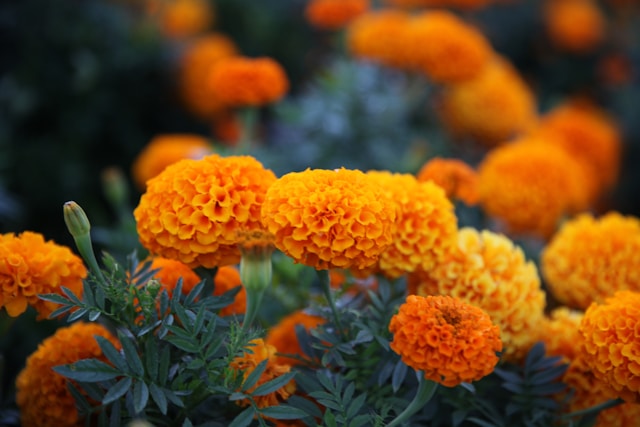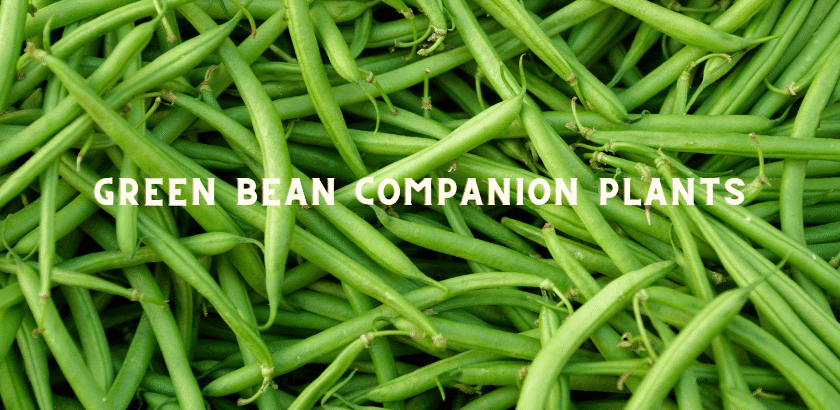In the harmonious world of gardens, green beans stand out not just for their nutritional value but also for their role in companion planting. This approach enhances biodiversity, improves pest control, and boosts overall garden health.
Here’s an insightful exploration into green beans and their companion plants, shedding light on the synergies within your garden.
Good Companion Plants for Green Beans:
The following table lists plants that are beneficial companions to green beans, enhancing growth and pest control:
| Plant | Benefits |
|---|---|
| Marigold | Repels bean beetles and nematodes |
| Nasturtium | Deters aphids and beetles; attracts pollinators |
| Corn | Provides shade and support; green beans fix nitrogen for corn |
| Carrots | Loosens soil around green beans; mutual benefit |
| Lettuce | Green beans provide partial shade; water conservation |
| Peas | Similar nitrogen fixation benefits; good for rotation |
| Spinach | Benefits from the shade and nitrogen fixation |
| Rosemary | Repels bean beetles and improves flavor |
| Potatoes | Green beans deter Colorado potato beetles |
| Cucumbers | Mutual space utilization; complementary growth patterns |
Marigold – Nature’s Pest Patrol for Beans

Marigolds are more than just cheerful garden flowers—they’re one of the best natural defenders you can plant alongside green beans. Their strong scent is known to repel bean beetles, aphids, and harmful nematodes, acting like a living shield around your crop. They also improve the health of the surrounding soil through their root secretions.
- USDA Zones: Suitable for Zones 2–11, though often grown as annuals.
- Soil Requirements: Thrive in well-drained, moderately fertile soil.
- Height and Spread: Depending on the variety, they range from 6 inches to 3 feet tall and spread about 1–1.5 feet wide.
- Growing Conditions: Full sun is ideal. Water when the topsoil feels dry.
- Recommended Fertilizers: A balanced 10-10-10 fertilizer once at planting is enough.
- Extra Tip: Plant marigolds around the perimeter of bean beds to create a visual and olfactory barrier against pests.
Nasturtium – The Sacrificial Guardian
Nasturtiums are beloved by pollinators and loathed by pests—a dream team combo for your green bean patch. They attract aphids and beetles away from beans (sacrificial trap cropping), while also bringing in pollinators to support your garden ecosystem. Their edible flowers and leaves are an added bonus for gardeners.
- USDA Zones: Perennial in Zones 9–11; annual elsewhere.
- Soil Requirements: Well-drained, low-fertility soil promotes more blooms than leaves.
- Height and Spread: Bush varieties grow up to 1 foot; trailing types can sprawl 6–10 feet.
- Growing Conditions: Full sun to partial shade; tolerant of poor soils.
- Recommended Fertilizers: Skip the fertilizer—too much nitrogen reduces flowering.
- Extra Tip: Use nasturtiums to draw aphids away from green beans. Remove and compost infested plants to break the pest cycle.
Corn – The Classic Climbing Support
Corn and green beans are a time-tested pair from Native American “Three Sisters” gardening. The tall, sturdy corn stalks provide a natural trellis for climbing bean vines, while beans enrich the soil with nitrogen, reducing corn’s heavy feeding demands.
- USDA Zones: Best in Zones 4–10.
- Soil Requirements: Deep, loamy, nutrient-rich soil with good drainage.
- Height and Spread: Grows 5–12 feet tall; spacing is 12–18 inches apart.
- Growing Conditions: Needs full sun, frequent watering during tasseling and ear development.
- Recommended Fertilizers: Use high-nitrogen fertilizer early (16-6-4), then switch to balanced or phosphorus-rich during pollination.
- Extra Tip: Plant corn in blocks (not rows) to ensure good pollination.
Carrots – The Soil Loosener
Carrots and green beans coexist peacefully below ground and above. Carrots loosen the soil with their taproots, improving root aeration for green beans. Because carrots grow slowly and beans quickly, they don’t compete aggressively for space or nutrients.
- USDA Zones: Ideal for Zones 3–10.
- Soil Requirements: Light, sandy, rock-free soil is critical for proper root development.
- Height and Spread: Generally 6–12 inches tall; minimal spread.
- Growing Conditions: Cool weather, full sun or light shade; consistent moisture helps prevent cracking.
- Recommended Fertilizers: Go for low-nitrogen, high-potassium blends (like 5-10-10).
- Extra Tip: Thin carrot seedlings once sprouted to prevent overcrowding and twisted roots.
Lettuce – The Cool Companion
Lettuce is a shade-lover and benefits immensely from the partial canopy that bean plants provide. This pairing reduces water evaporation and prevents lettuce from bolting (flowering prematurely) in warmer weather, allowing a longer harvest window.
- USDA Zones: Best grown in Zones 4–9.
- Soil Requirements: Moist, rich, well-drained soil high in organic matter.
- Height and Spread: Grows 6–12 inches tall and wide.
- Growing Conditions: Prefers cool temperatures and partial shade in warmer zones.
- Recommended Fertilizers: Organic nitrogen sources like blood meal or composted manure work well.
- Extra Tip: Sow lettuce seeds between bean rows to maximize space and extend harvest.
Peas – Nitrogen Buddies
Like beans, peas are legumes and excellent nitrogen fixers. While they shouldn’t be planted at the same time in the same spot, they are perfect for crop rotation with green beans. Planting peas first in early spring helps improve soil conditions for a mid-season bean crop.
- USDA Zones: Thrive in Zones 3–11.
- Soil Requirements: Loose, loamy, well-drained soil; neutral pH.
- Height and Spread: Climbing peas reach 5–6 feet; bush peas stay under 2 feet.
- Growing Conditions: Prefer cool weather; plant as early as soil can be worked.
- Recommended Fertilizers: Use phosphorus-heavy fertilizers; avoid excess nitrogen.
- Extra Tip: Rotate peas and beans to naturally refresh the soil between seasons.
Spinach – A Shade-Loving Ally
Spinach is a cool-weather crop that loves the dappled shade green beans provide. It takes advantage of nitrogen-enriched soil and avoids heat stress by growing beneath the canopy of taller bean plants.
- USDA Zones: Best in Zones 5–10.
- Soil Requirements: Rich, moist, well-drained soil with compost.
- Height and Spread: 6–12 inches tall and wide.
- Growing Conditions: Grows best in spring or fall; partial shade preferred in warm areas.
- Recommended Fertilizers: Use nitrogen-heavy organic fertilizers like fish emulsion.
- Extra Tip: Harvest outer leaves frequently to promote regrowth and prolong the season.
Rosemary – Scented Defense
Rosemary’s strong aroma is a deterrent to bean beetles and many other pests. Although it doesn’t contribute much to soil enrichment, its pest-repelling powers make it a smart choice for borders or nearby containers.
- USDA Zones: Grows perennially in Zones 7–11.
- Soil Requirements: Well-drained, slightly sandy soil; pH 6–7.5.
- Height and Spread: 2–4 feet tall and wide; can be pruned for shape.
- Growing Conditions: Needs full sun; drought-tolerant once established.
- Recommended Fertilizers: Minimal feeding needed; compost is often sufficient.
- Extra Tip: Avoid waterlogged soil, as rosemary is susceptible to root rot.
Potatoes – A Defensive Duo
Potatoes benefit from green beans’ ability to deter Colorado potato beetles. Although they have different nutrient requirements and underground growth patterns, they coexist well if spaced adequately.
- USDA Zones: Typically grown in Zones 3–10.
- Soil Requirements: Loose, acidic, well-drained soil; no fresh manure.
- Height and Spread: Plants reach 1–3 feet tall and wide.
- Growing Conditions: Full sun; mound soil around stems as plants grow.
- Recommended Fertilizers: Use low-nitrogen, high-potassium blends.
- Extra Tip: Don’t plant beans and potatoes too close—leave room for mounding and harvesting.
Cucumbers – The Efficient Sprawlers
Green beans and cucumbers grow in complementary ways—beans climb up while cucumbers spread across the ground. They also share similar sun, water, and soil needs, making them low-conflict companions in small spaces.
- USDA Zones: Thrive in Zones 4–11.
- Soil Requirements: Loose, fertile, well-draining soil rich in compost.
- Height and Spread: Vines can sprawl up to 6 feet; bush varieties are more compact.
- Growing Conditions: Full sun, regular moisture, warm weather.
- Recommended Fertilizers: Begin with a balanced (10-10-10) fertilizer, then switch to potassium-rich as flowering begins.
- Extra Tip: Use vertical trellising for cucumbers to save space and reduce disease risk.
Bad Companion Plants for Green Beans:
Conversely, some plants can have adverse effects on green beans, inhibiting their growth or attracting pests:
| Plant | Reason for Incompatibility |
|---|---|
| Garlic | Inhibits the growth of green beans |
| Onions | Similar to garlic, affects growth negatively |
| Peppers | May compete for nutrients; potential pest issues |
| Sunflowers | Can inhibit green bean growth |
| Fennel | Inhibits growth; attracts pests |
| Beets | Compete for nutrients; root space issues |
| Kale | Competes for space and nutrients |
| Brussels Sprouts | Similar to kale, competition for resources |
| Eggplants | Can attract pests that also affect green beans |
| Chives | Like onions and garlic, can inhibit growth |
Vegetable Companion Plants:
Focusing on vegetable companions, green beans thrive when paired with certain veggies due to shared benefits and pest management synergy.
| Vegetable | Benefits |
|---|---|
| Corn | Acts as a natural trellis; mutual support |
| Squash | Shares space efficiently; pest control synergy |
| Carrots | Loosen soil, enhancing green bean root health |
| Lettuce | Benefits from green beans’ shade; conserves moisture |
| Peas | Shares nitrogen-fixation benefits; good for crop rotation |
| Spinach | Thrives in the partial shade provided by green beans |
| Radishes | Repels pests; green beans can provide shade |
| Beets | While competitive, can be managed with careful spacing |
| Cabbage | Complementary growth; shared pest management |
| Potatoes | Beneficial for deterring specific pests |
Companion planting with green beans not only optimizes space and resources but also fosters a vibrant, self-sustaining garden ecosystem. Embracing this practice can lead to healthier plants, reduced pest issues, and a more productive harvest.
References:
- Szafirowska, Dr Anna, and Kolosowski, MSc Slawomir. “Organic Eprints – the Effect of Companion Plants on Lygus Feeding Damage to Bean.”
https://orgprints.org/id/eprint/12179/ - Finch, Stanley, and Rosemary Collier. “The Influence of Host and Non‐Host Companion Plants on the Behaviour of Pest Insects in Field Crops.” Entomologia Experimentalis et Applicata, vol. 142, no. 2, 9 Nov. 2011, pp. 87–96,
https://onlinelibrary.wiley.com/doi/full/10.1111/j.1570-7458.2011.01191.x
These studies and articles delve into the scientific principles behind companion planting, offering insights into how green beans interact with their environment and neighboring plants, promoting a healthier and more productive garden.
Zaki Infitar is the driving force and creative mind behind GreenBuilt.co. As a self-taught gardener with an unwavering passion for all things green, Zaki’s journey into the world of gardening is a testament to his dedication and love for nature.

